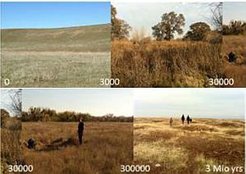Soil weathering: A key player in carbon cycling

Quantifying soil C dynamics is of utmost relevance in the context of global change as soils play an important role in land-atmosphere gas exchange. Whether C is stored in soils or released back to the atmosphere is usually related to climatic factors and land management, as they control plant growth and the decomposition activity of soil microorganisms. Geology, however, can be seen as the long-term and larger-scale geochemical background in which soils develop with their C storage capacity.
An international team of researchers including Prof Susan Trumbore from the Max Planck Institute for Biogeochemistry, Germany, shows why it is important to understand long-term geological changes like mineral weathering when assessing short-term responses of soil C dynamics.
The scientists worked along a soil chronosequence with increasing weathering status in California that originated from the same geologic material and developed under similar climate and vegetation cover. The youngest soils along this sequence are only a few years old, whereas the oldest and highly weathered soils are several million years old.
“This difference in the soil’s weathering stage allowed us to investigate all kinds of changes relevant for the C cycle that occur with time. For example, changes in vegetation types due to differing availability of nutrients, changes in microbial communities and their strategies to assess these nutrients, the capacity of minerals to stabilize C in soils and even the effect that warming might have on certain biological processes” Trumbore explains. The researchers demonstrate that biogeochemical alteration of the soil matrix (and not short-term warming) controls the composition of microbial communities and strategies to metabolize nutrients. As a general rule, weathering first increases and then reduces nutrient availability and retention, as well as the potential of soils to stabilize C.
So how does this knowledge help us to improve predictions of the future C cycle?
“The great thing about our study is that we show how closely biological processes acting on short time scales are tied to these long term changes in soils that come with weathering” Trumbore continues. The scientists hope that this understanding helps to better integrate weathering mechanisms into models by ecologists and biochemists to predict C at the global scale. If biology, that drives the C cycle, is taking place on a stage that is controlled by geochemical changes in soils, they can use much simpler approaches and larger datasets on soil properties and underlying geology to create better predictions of future C cycle developments.
Original publication:
Full title: Doetterl S., Arnold C., Berhe A.A., Bodé S., Boeckx P., Fiener, P., Finke P., Fuchslueger L., Griepentrog, M., Harden J.W., Nadeu E., Schnecker J., Six J., Trumbore S., Van Oost, K., Vogel C. 2018.
Links among warming, carbon and microbial dynamics mediated by soil mineral weathering.
Nature Geoscience, DOI: https://doi.org/10.1038/s41561-018-0168-7.
Contact:
Prof Susan E. Trumbore
phone: +49 3641 576110
e-mail: trumbore@bgc-jena.mpg.de
